Has a problem been found?

Repair as necessary and go to "Verification of Vehicle Repair" procedure.

Go to "Power Circuit Inspection" procedure.
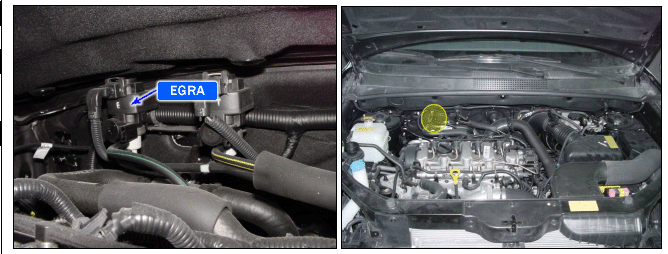
The EGR (Exhaust Gas Recirculation) system is used to divert some of the exhaust gas to the engine inlet system in order to reduce an excess of air and the temperature in the combustion chamber.
This device also significantly reduces emissions of the nitric oxides at the exhaust.
The EGR system is composed of a solenoid valve, a proportional pneumatic valve and an air flow meter.
The EGR solenoid valve controls the opening and closing the pneumatic valve using the low pressure from the braking assistance circuit. The low pressure is created by the vaccum pump located at the end of the alternator.
The duty control of the solenoid valve is determined by the injection computer depending on the air flow requested.
In case of EGR solenoid valve failure, the engine performance will be reduced.
If the EGR control circuit is generated threshold value, the ECM judged this as a fault and DTC is set.
Item | Detecting Condition | Possible Cause |
DTC Strategy | ● Circuit continuity check | ● Short in power circuit ● Short to battery in relay control circuit ● Fuse blown ● Faulty EGR actuator ● Faulty ECM |
Enable Conditions | ● Engine run | |
Threshold Value | ● Short for EGR actuator control circuit | |
Diagnostic Time | ● 0.48 sec. | |
MIL Fuel Limit Fuel Cut EGR Off | ● Yes ● No ● No ● Yes |
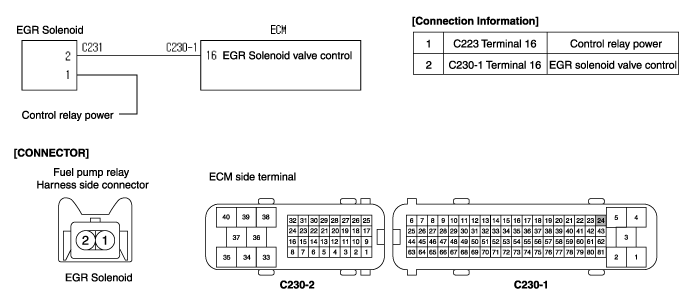

Connect scantool to Data Link Cable (DLC).
Warm up engine to normal operating temperature.
Monitor that "Mass Air Flow Sensor" parameter on the scantool is changing without EGR actuator operation or with EGR actuator operation while idling engine speed.
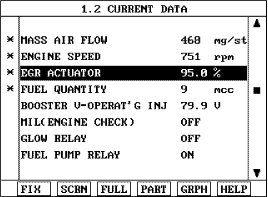

Fig 1) Normal value without EGR actuator : Approx. 450 ~ 550 mg/stroke
Fig 2) Normal value with EGR actuator : Approx. 280 ~ 360 mg/stroke
Is Current data displayed correctly ?

▶ Fault is intermittent caused by poor contact in the sensor’s and/or ECM’s connector or was repaired and ECM memory was not cleared. Thoroughly check connectors for looseness, poor connection, bending, corrosion, contamination, deterioration, or damage. Repair or replace as necessary and go to "Verification of Vehicle Repair" procedure.

▶ Go to "W/Harness Inspection" procedure.
Many malfunctions in the electrical system are caused by poor harness and terminals.
Faults can also be caused by interference from other electrical systems, and mechanical or chemical damage.
Thoroughly check connectors for looseness, poor connection, bending, corrosion, contamination, deterioration, or damage.
Has a problem been found?

Repair as necessary and go to "Verification of Vehicle Repair" procedure.

Go to "Power Circuit Inspection" procedure.
Ignition "OFF" & Engine "OFF".
Disconnect EGR solenoid valve connector.
Ignition "ON" & Engine "OFF".
Measure voltage between terminal 1 of the EGR solenoid valve harness connector and chassis ground
Specification : Approx. B+

Is the measured voltage within specifications ?

▶ Go to " Control Circuit Inspection " procedure.

▶ Check for open or short in power harness.
Repair as necessary and go to "Verification of Vehicle Repair" procedure.
Ignition "OFF" & Engine "OFF".
Disconnect EGR solenoid valve connector.
Measure voltage between terminal 2 of EGR solenoid valve harness connector and chassis ground.
Specification : Approx. below 1V
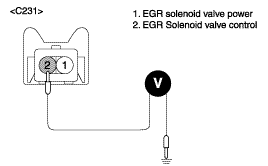
Is the measured voltage within specifications ?

▶ Go to " Component Inspection" procedure

▶ Check for short to battery in harness.
Repair as necessary and go to "Verification of Vehicle Repair" procedure.
Check for open in EGR solenoid valve
Ignition "OFF".
Disconnect EGR connector.
Measure resistance between terminal 1 and 2 of EGR solenoid valve connector.
Specification : 14 ~ 17 Ω (20°C)
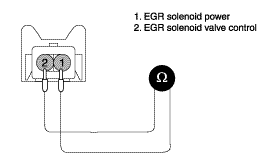
Is the measured resistance within specifications ?

▶ Go to "Check EGR solenoid operation" as below.

▶ Check EGR solenoid for contamination, deterioration, or damage. Substitute with a known-good EGR and check for proper operation. If the problem is corrected, replace EGR and then go to "Verification of Vehicle Repair" procedure.
Check EGR solenoid valve operation
Ignition "ON" & Engine "ON".
Confirm that EGR solenoid valve Duty is 5% after warming-up Engine.
Be sure that vacuum is felt after disconnecting vaccum hose from EGR solenoid valve.
Check that vacuum is felt in idle after sudden accelleration(EGR solenoid valve Duty : 95%)
Conduct this test at least twice or three times.
EGR DUTY : 5% | EGR DUTY : 95% |
No Vaccum | Vacuum |
Is the vaccum felt from vaccum hose according to EGR DUTY ?

▶ Substitute with a known-good ECM and check for proper operation. If the problem is corrected, replace ECM and then go to "Verification of Vehicle Repair" procedure.

▶ Check EGR solenoid for contamination, deterioration, or damage. Substitute with a known-good EGR and check for proper operation. If the problem is corrected, replace EGR and then go to "Verification of Vehicle Repair" procedure.
After a repair, it is essential to verify that the fault has been corrected.
Connect scan tool and select "Diagnostic Trouble Codes(DTCs)" mode and then clear DTC.
Operate the vehicle within DTC Enable conditions in General information.
Are any DTCs present ?

Go to the applicable troubleshooting procedure.

System is performing to specification at this time.